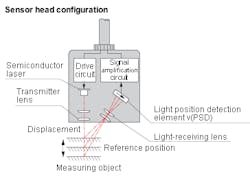Displacement sensors measure the distance an object moves, and they can also be used to measure object height and width. There are two types of displacement sensors, according to MeasureCentral.com, a website from Keyence: Contact types, using a dial gauge, differential transformer, etc., and non-contact types, which use a magnetic field, laser beam, ultra-sonic wave or other technologies. Laser displacement sensors provide high accuracy are good at non-contact detection of objects. Besides Keyence, other vendors who provide laser displacement sensors include Omron and Cognex.
The DS1100 laser-displacement sensor from Cognex, released in March 2013, is part of Cognex’s 3D laser-profiling series of sensors that also determine an object’s proper shape. Because it provides object height on the production line at higher accuracy—to 5 microns—as well as the usual two-dimensional length and width of objects, it can be particularly useful in the food and beverage industries. “For example, it can provide the volumes of products such as cookies and donuts on the line,” says Bob Tremblay, former applications engineer and current manager of product marketing for Cognex.
Since the sensor also can describe object shape, it’s used on bottling lines to check the seating of the caps. Or perhaps a candy bar manufacturer needs to check packages of chocolate bars to determine the presence or absence of the correct count of bars in a box. “Present/absence of height change makes it much simpler to determine that,” Tremblay says.
Tire producers use this technology to identify the raised characters on both sides of tires. “In the past, with optical-character recognition, [this application] was a lighting nightmare,” Tremblay says. But using a laser-displacement sensor that can see a difference of 1 millimeter in height of sidewall features means that any change in height appears as a contrast in the image, because any raised/lowered character will give different contrast.
Food and beverage applications of the IL Series laser displacement sensors from Keyence include use on stacker, palletizer and packaging machinery. “The IL Series can provide stacking device counts and identify stacking disturbances through the non-contact detection, providing reliable detection regardless of color changes in the targets,” according to a spokesman.
Another application is detection of roll chucks for film winding on packaging machines, which can save large amounts of manual adjustment time. Laser displacement sensors are also used for non-contact liquid-level detection in, for example, a tank of chocolate.
>> Read Automation World's complete coverage on sensors, "From Measurement to Intelligence Gathering".
About the Author
Renee Bassett
Managing Editor

Leaders relevant to this article:
